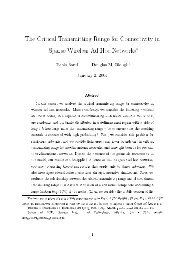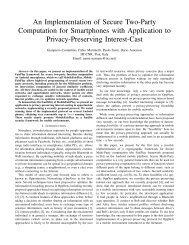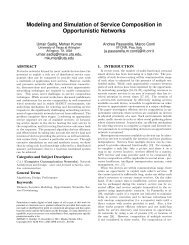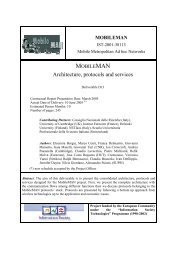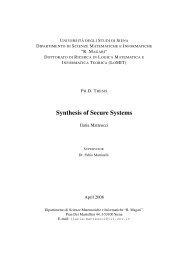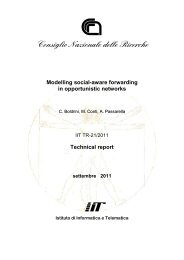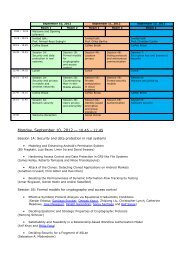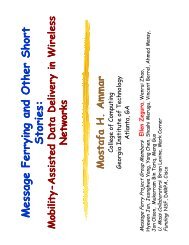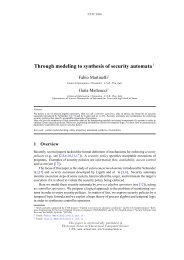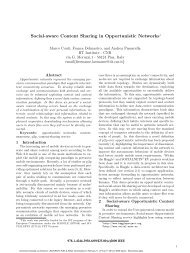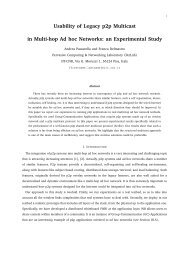Data Dissemination in Opportunistic Networks using ... - IEEE Xplore
Data Dissemination in Opportunistic Networks using ... - IEEE Xplore
Data Dissemination in Opportunistic Networks using ... - IEEE Xplore
You also want an ePaper? Increase the reach of your titles
YUMPU automatically turns print PDFs into web optimized ePapers that Google loves.
decision-mak<strong>in</strong>g processes [11], forecast<strong>in</strong>g future purchaseactivities [7] or even sport events results [13] or politicalelection outcomes [10].IV. THE RECOGNITION HEURISTIC FOR DATADISSEMINATION IN OPPORTUNISTIC NETWORKSTo def<strong>in</strong>e how to exploit the recognition heuristic, hereafterwe consider a scenario <strong>in</strong> which each data item perta<strong>in</strong>sto a specific channel (or <strong>in</strong>terest). Each node generatesand owns some items of possibly different channels. It is<strong>in</strong>terested <strong>in</strong> retriev<strong>in</strong>g and keep<strong>in</strong>g items belong<strong>in</strong>g to aspecific channel only. In this scenario nodes collaborativelycontribute to the diffusion of <strong>in</strong>formation by stor<strong>in</strong>g andexchang<strong>in</strong>g some of the items they discover com<strong>in</strong>g <strong>in</strong>contact with other devices, even if those items do not belongto the channel they are <strong>in</strong>terested <strong>in</strong>. We assume that nodecontribute a limited shared storage space to the diffusionprocess (whose size is throughout denoted with S). Thediffusion process happens through contacts between nodes.When two nodes come <strong>in</strong> contact, they exchange summariesof their data items. The node ranks data items stored by itselfand by the encountered peer accord<strong>in</strong>g to their utility, andupdates its storage space by stor<strong>in</strong>g the most useful itemsonly (until the storage space is full). Comput<strong>in</strong>g the utilityof items for the diffusion process is a hard (or impossible)target criterion to evaluate for a s<strong>in</strong>gle node, as it requires<strong>in</strong> general complete knowledge of the status of the network.Thus, the application of a simple, fast and effective strategysuch as the recognition heuristic can significantly reduce thecomplexity of evaluat<strong>in</strong>g this criterion.In order to exploit the recognition heuristic, the first stepis to def<strong>in</strong>e the elements upon which recognition will bemade. After that, we need to design a proper algorithmthat, start<strong>in</strong>g from the recognition heuristic, effectively filtersthe <strong>in</strong>formation, with the aim of maximiz<strong>in</strong>g the utilityof the exchange of objects among nodes. To this end, <strong>in</strong>this section we characterize the elements that allow to usethe recognition heuristic <strong>in</strong> this environment. In the nextsection, we def<strong>in</strong>e an algorithm that relies on this heuristic,a modified version from one present <strong>in</strong> the cognitive scienceliterature. The aim of this algorithm is to limit as much aspossible the use of precise attributes and complex operationsby effectively filter<strong>in</strong>g out most of the <strong>in</strong>formation us<strong>in</strong>g therecognition heuristic only.In order to use the recognition heuristic <strong>in</strong> our scenario,some steps must be followed. Specifically, we have toidentify:• the features (like the name of cities or universities <strong>in</strong> theexamples of Goldste<strong>in</strong> and Gigerenzer) that are highlycorrelated with the selection criterion and that are thusspread by the mediators;• the environmental mediators;• the way by which nodes implement the heuristic basedon the <strong>in</strong>formation collected from mediatorsAs for the first po<strong>in</strong>t, we consider two simple factors thatdeterm<strong>in</strong>e the utility of a data item, i.e., the popularity of itschannel, and its availability (these factors have always beenconsidered as fundamental <strong>in</strong> the data management literature,start<strong>in</strong>g from the area of web cach<strong>in</strong>g [1]. Specifically,the utility of a data items is positively correlated with thepopularity of its channel (how many users are <strong>in</strong>terested<strong>in</strong> that item), and negatively correlated with its availability(how many times that item is already replicated).As for the second po<strong>in</strong>t, we use nodes themselves asmediators, while the variables they spread are, respectively,the channel they are <strong>in</strong>terested <strong>in</strong>to, and the set of items theyare currently stor<strong>in</strong>g <strong>in</strong> their shared storage space.As for the third po<strong>in</strong>t, the bottoml<strong>in</strong>e idea is to use tworecognition heuristics to separately recognize channels anddata items. Intuitively, a node recognizes a channel as soonas it becomes “enough popular”, i.e., as soon as the nodeencounters enough nodes that are <strong>in</strong>terested <strong>in</strong> that channel.Furthermore, a node recognizes a data item it is “spreadenough”, i.e., as soon as it is encountered on at least agiven number of other nodes. This approach is very similarto what is referred to as <strong>in</strong>ference-from-memory <strong>in</strong> [5]. Morespecifically, each node ma<strong>in</strong>ta<strong>in</strong>s a separate recognitioncache for channels and data items. Entries of the cachecorrespond to channels of <strong>in</strong>terest for or data items carriedby encountered nodes, respectively. Each entry conta<strong>in</strong>s acounter and a TTL associated with the channel or data item.Whenever a node <strong>in</strong>terested <strong>in</strong> a channel (or stor<strong>in</strong>g a dataitem) is encountered, the associated counter is <strong>in</strong>crementedand the TTL reset. When the counter reaches a certa<strong>in</strong>threshold, the correspond<strong>in</strong>g channel or data item is deemedas recognized. Furthermore, the TTL is <strong>in</strong>cremented at eachtime slot. When the cache becomes full and replacementmust occur, the entry with the highest TTL is selected forreplacement. If it corresponds to a recognized channel (ordata item), this entry is stored <strong>in</strong> a Bloom filter. Otherwise,it is dropped. The complete recognition algorithm is shown<strong>in</strong> Algorithm 1.Intuitively the algorithm keeps track of encountered channelsor data items until they are recognized. When the cacheis empty, the entry correspond<strong>in</strong>g to the least recently seenobject is selected. Bloom filters allow nodes to dist<strong>in</strong>guish,among entries that are not <strong>in</strong> the cache, those that correspondto recognized items (stored <strong>in</strong> the Bloom filter), and notrecognized items. This is important <strong>in</strong> case such items areencountered aga<strong>in</strong>, as, if they are <strong>in</strong> the Bloom filter, they canbe immediately recognized aga<strong>in</strong>. Note that this algorithmmimics the way <strong>in</strong> which the human bra<strong>in</strong> refreshes, flushesand recalls “items” <strong>in</strong> memory.V. A MODIFIED Take The Best ALGORITHM FOROPPORTUNISTIC NETWORKSHav<strong>in</strong>g described how to implement heuristics, we nowpresent an algorithm that exploit them <strong>in</strong> the data dissem<strong>in</strong>ationprocess. Also <strong>in</strong> this case, we take <strong>in</strong>spiration from thecognitive psychology literature [6]. The algorithm def<strong>in</strong>ed<strong>in</strong> [6] (named Take the Best) mimics a fast and frugal wayof reason<strong>in</strong>g for choos<strong>in</strong>g among two alternatives. The goalof the algorithm is compar<strong>in</strong>g two objects. To this end,objects are tested aga<strong>in</strong>st an ordered set of cues, stopp<strong>in</strong>gat the first (best) cue that discrim<strong>in</strong>ates among them. Whennone of the cues can discrim<strong>in</strong>ate, the algorithm choosesby some additional discrim<strong>in</strong>at<strong>in</strong>g criterion, which usuallyrequires much more complex <strong>in</strong>formation to be evaluated
Algorithm 1 Recognition algorithm1: Let i be an observed channel/item;2: Let H be a hashed <strong>in</strong>dex of removed channels/items3: Let R θ be the recognition threshold4: if Cache.conta<strong>in</strong>s( i ) then5: Increment i counter6: reset i.TTL7: else8: if Cache is full then9: Select the item o with the oldest TTL10: if o.counter ≥ R θ then11: Move o to H12: end if13: Drop o14: end if15: Put i <strong>in</strong> the Cache16: i.counter = 117: Set i.TTL18: end ifStartChannelRecognition# Recognized and old itemslower than SFigure 2.AvailabilityRecognitionStore theItemsMerge With theActual MemoryContentTake the first S objectsModified Take The Best AlgorithmAvailabilityRankwith respect to the cues. We propose to adapt this algorithm<strong>in</strong> the scenario we are consider<strong>in</strong>g. When a node meetsanother peer, it ranks the objects of the other node us<strong>in</strong>gan adaptation of the Take The Best algorithm, depicted <strong>in</strong>Fig. 2 and Algorithm 2. The first two cues we consideredconsist of the recognition of channels and items, us<strong>in</strong>g thealgorithm presented <strong>in</strong> Section IV. The first cue is thechannel recognition: items of recognized channels are rankedhigher than the others and selected for the next steps. Ifthe total size of rema<strong>in</strong><strong>in</strong>g items (consider<strong>in</strong>g both the nodeand the peer shared storage spaces) is greater than S (thesize of the node’s shared storage space), items are furtherdiscrim<strong>in</strong>ated us<strong>in</strong>g the second cue, i.e. the recognitionof items. In this case the recognition assumes a negativemean<strong>in</strong>g, as recognized items (already very spread) areranked lower than the others and they are not consideredanymore. If further discrim<strong>in</strong>ation have to be carried outto fill the node’s shared storage space, the precise valueof estimated availability of items is considered, and lessavailable items are ranked higher. As for the orig<strong>in</strong>al TakeThe Best Algorithm, not all the steps are required, and thelast (and more costly) one is run only on a subset of theitems.A. The Less–is–More EffectGoldste<strong>in</strong> and Gigerenzer show that the recognitionheuristic [5] and the Take The Best algorithm are subjectto the so-called less–is–more effect [6]: When <strong>in</strong>creas<strong>in</strong>gthe number of recognized items, the number of accurate<strong>in</strong>ferences will <strong>in</strong>crease up to a certa<strong>in</strong> po<strong>in</strong>t, but thereafterdecrease. This is due to the dim<strong>in</strong>ished discrim<strong>in</strong>ation powerof the recognition heuristic, s<strong>in</strong>ce too many items are recognizedat the same time. In order to take advantage of theAlgorithm 2 Modified Take The Best Algorithm1: Let R be a set of items received from another node;2: M be the actual storage content3: Let S be the storage capacity limit4: Let C be the channel chache and O be the item cache5: Let H C and H I be the hashes of old recognized channels and items6: Let RC θ be the recognition threshold for channels7: Let RI θ be the recognition threshold for items8: Let I = R − M9: Let recChannels = ∅10: for each i ∈ I do11: if C.conta<strong>in</strong>s(i.channel) & i.channel.counter ≥ RC θ ORH C .conta<strong>in</strong>s(r) then12: recChannles ∪ = i13: end if14: end for15: Let recItems = ∅16: if recChannels.size + M.size > S then17: for each r ∈ recChannels do18: if (O.conta<strong>in</strong>s(r) & NOT r.counter ≥ RI θ ) OR NOTH I .conta<strong>in</strong>s(r) then19: recItems ∪ = r20: end if21: end for22: if recItems.size + M.size > S then23: Let M ′ = M ∪ recItems24: Rank M ′ <strong>in</strong> ascend<strong>in</strong>g order accord<strong>in</strong>g to the counters of itsitems25: Select and keep <strong>in</strong> M the first S objects of M ′26: else27: M ∪ = recItems28: end if29: else30: M ∪ = recChannels31: end ifless–is–more effect, the storage capacity of the recognitioncaches should be adapted <strong>in</strong> order to achieve the maximumaccuracy. Identify<strong>in</strong>g autonomic algorithms to adjust thiscapacity is one of the key directions of future work.VI. EXPERIMENTAL RESULTSWe evaluate the proposed algorithm by simulat<strong>in</strong>g thefollow<strong>in</strong>g scenario. We consider 45 nodes, divided <strong>in</strong>to threedifferent groups. In order to simulate real user movementpatterns, nodes move <strong>in</strong> a 4 x 4 grid (1000 m wide),accord<strong>in</strong>g to the HCMM model [3]. The HCMM modelis a mobility model that <strong>in</strong>tegrates temporal, social andspatial notions <strong>in</strong> order to obta<strong>in</strong> an accurate representationof real user movements. In the simulation scenario, groupsrepresent set of users that have social and spatial relationships.Groups are <strong>in</strong>itially assigned to a home cell and anyphysical contact among groups is avoided. Thus, the onlyway to exchange and obta<strong>in</strong> data among groups is throughnode mobility. Nodes can move <strong>in</strong> the cell of their grouponly. A few nodes <strong>in</strong> each group (named travellers) bridgebetween communities by visit<strong>in</strong>g more than one group.This model well represents social communities, <strong>in</strong> whichpeople typically stay, with a few people commut<strong>in</strong>g betweendifferent communities due to different social relationships.In the simulation sett<strong>in</strong>gs, each group has two travellers,one for each of the other groups. The objects available <strong>in</strong>the network are assigned to channels and there are as manychannels (n c ) as groups. Each channel has a total of 99objects and each group orig<strong>in</strong>ates 1/n c items per channel,i.e. there are 33 items of each channel per group. All theobjects are generated at the start of the simulation. Each
node subscribes to one channel only. With<strong>in</strong> each group,node <strong>in</strong>terests follow a Zipf law with parameter 1. Interestsare rotated, so that the most popular channel <strong>in</strong> a groupis the second <strong>in</strong> another and the third one <strong>in</strong> the other,and so on. Note that <strong>in</strong> this scenario data items can reach<strong>in</strong>terested users <strong>in</strong> communities other than those where theyare generated only through nodes mobility. Therefore, itallows us to highlight the effectiveness of the data dissem<strong>in</strong>ationalgorithm. The simulation runs for 50,000 seconds.At the start of the simulation each node subscribes to a givenchannel. The performance figure is the hit rate, computed atvarious time <strong>in</strong>stants after the simulation starts. It is def<strong>in</strong>edas the ratio between the number of retrieved objects of thesubscribed channel and the total amount of objects of thechannel. By default, on each node, the channel recognitioncache size is 3 (i.e. all channels can be recognized), the itemsrecognition cache is 10, and the shared storage space has 10slots (items are assumed to be of equal size). Simulationhave been replicated <strong>in</strong> <strong>in</strong>dependent conditions 10 times,and confidence <strong>in</strong>tervals (with 95% confidence level) havebeen computed. As they are very narrow, <strong>in</strong> the plot we onlyshow the central values of the confidence <strong>in</strong>tervals.Simulations were run chang<strong>in</strong>g the values of the thresholdsfor both the channel and the items recognitions and byvary<strong>in</strong>g size of the shared storage space, S. The first set ofexperiments (Figs. 3–4) shows, first of all, that by us<strong>in</strong>g therecognition heuristic the system is able, after some time, toreach 100% hit rate. This is a very important result. Us<strong>in</strong>gthe proposed recognition heuristic result <strong>in</strong> an extremelylightweight data dissem<strong>in</strong>ation system, which neverthelessproves to be very effective. Another aspect highlighted bythis set of results is the effect of vary<strong>in</strong>g the item recognitionthreshold with different values of the channel recognitionthreshold. The ma<strong>in</strong> result is that for very low value ofthe item threshold (RI θ = 2) the <strong>in</strong>formation diffusionalgorithm is not able to obta<strong>in</strong> a 100% hit rate. For theother values, changes <strong>in</strong> the item threshold implies little oralmost no differences <strong>in</strong> the algorithm performance. Thisresults (particularly evident <strong>in</strong> Fig. 4) are a sign of theless−is−more effect. In order to have a <strong>in</strong>-depth analysesof this case, Fig. 5 shows the results obta<strong>in</strong>ed by fix<strong>in</strong>gRI θ = 2 and vary<strong>in</strong>g the channel threshold. Such a lowvalue of the item threshold implies a higher probability ofrecogniz<strong>in</strong>g items as widespread. As a consequence, at agiven time all the items are recognized as too diffused byall the nodes. In this case, items are not exchanged anymore,s<strong>in</strong>ce all of them are not recognized as useful. In the othercases <strong>in</strong> Fig. 3 and 4, not all the items were recognized as toodiffused, thus allow<strong>in</strong>g to reach a 100% hit rate. RI θ = 2,as <strong>in</strong> Fig. 5, always leads to lower performances. Moreover,this figure highlights that different values of the channelthreshold imply different <strong>in</strong>formation diffusion speeds. Thelower RC θ , the more rapid the convergence of the algorithm.The longer it takes to converge, the higher is the probabilityfor a node to see more copies of a given data before start<strong>in</strong>gto take it. Thus, with a slower convergence rate, is moreprobable to have all the items recognized as widespreadat <strong>in</strong>creas<strong>in</strong>gly further po<strong>in</strong>ts from 100% of hit rate. TheHit Rate10.80.60.40.20Item Thr. = 2Item Thr. = 5Item Thr. = 101 10 100 1000 10000 100000TimeFigure 3. Hit Ratio with a Channel threshold = 3Hit Rate10.80.60.40.20Item Thr. = 2Item Thr. = 5Item Thr. = 101 10 100 1000 10000 100000TimeFigure 4. Hit Ratio with a Channel threshold = 10effect of RC θ values on the convergence speed is visiblealso with other values of RI θ . Fig. 6 reports the resultsachieved with RI θ = 10. In this case, the hit rate alwaysconverges to 100%, but , as <strong>in</strong> the previous figure , theconvergence velocity is strongly determ<strong>in</strong>ed by the differentvalues of RC θ . Fig. 7 highlights the effects of the sharedstorage space to the algorithm effectiveness. The results areobta<strong>in</strong>ed with RC θ = 2, RI θ = 5. The number of slots ofthe shared memory is fixed to 2 and 50, respectively. A largeramount of shared memory allows a greater replication factor,s<strong>in</strong>ce is more probable that multiple copies of the same datacan be stored by different nodes at the same time. This facteasy the diffusion of items, thus <strong>in</strong>creas<strong>in</strong>g the convergespeed. Nonetheless, even a very low number of slots doesnot affect the f<strong>in</strong>al performance (100% hit rate). On the otherhand, they result <strong>in</strong> a slower convergence rate, due to the<strong>in</strong>creased difficulty to share and spread items <strong>in</strong> the network.VII. CONCLUSIONSCognitive heuristics are models of how the human bra<strong>in</strong>assess the relevance of <strong>in</strong>formation us<strong>in</strong>g only partial knowl-Hit Rate10.80.60.40.20Ch. Thr. = 3Ch. Thr. = 5Ch, Thr. = 10Ch. Thr. = 151 10 100 1000 10000TimeFigure 5. Hit Ratio with an Item threshold = 2
Hit Rate10.80.60.40.20Ch. Thr. = 3Ch. Thr. = 5Ch. Thr. = 10Ch. Thr. = 151 10 100 1000 10000TimeFigure 6. Hit Ratio with an Item threshold = 10data dissem<strong>in</strong>ation efficiency. Specifically, analytical modelsare required to understand the impact and the <strong>in</strong>terplayof the parameters. For example, results presented <strong>in</strong> thepaper already highlight a non-trivial jo<strong>in</strong>t effect on thedata dissem<strong>in</strong>ation efficiency played by the thresholds usedby the different recognitions heuristics. Furthermore, understand<strong>in</strong>ghow data dissem<strong>in</strong>ation works when additionalcontext <strong>in</strong>formation (such as social relationships betweenusers) is exploited is another <strong>in</strong>terest<strong>in</strong>g topic. F<strong>in</strong>ally, it willalso be <strong>in</strong>terest<strong>in</strong>g to understand whether other heuristics(beyond recognition) can be effectively applied to the datadissem<strong>in</strong>ation or other related problems.Hit Rate10.80.60.40.2Mem = 2Mem = 50VIII. ACKNOWLEDGEMENTSThis work is funded by the EC under the FET-AWARENESS RECOGNITION Project, grant 257756.REFERENCES[1] Abdullah Balamash and Marwan Krunz. An overview of web cach<strong>in</strong>greplacement algorithms. <strong>IEEE</strong> Communications Surveys and Tutorials, 6(1-4):44–56, 2004.0Figure 7.1 10 100 1000 10000TimeHit Ratio with Variable Memory Sizesedge of the problem space and very limited resources. In thispaper we present an <strong>in</strong>itial attempt to exploit these models(already established and coded <strong>in</strong> the cognitive psychologyfield) to drive data dissem<strong>in</strong>ation processes <strong>in</strong> opportunisticnetwork<strong>in</strong>g environments. Specifically, we show how a fastand frugal cognitive heuristic, i.e. the recognition heuristic,can be used. The recognition heuristics discrim<strong>in</strong>ates objectswith respect to a given criterion, without requir<strong>in</strong>g to collectall the <strong>in</strong>formation needed to exactly compute the criterion.It assumes that recognized objects have higher value (withrespect to the criterion) than non recognized objects, anddiscrim<strong>in</strong>ates among them accord<strong>in</strong>gly. Several <strong>in</strong>stances ofrecognition can be cha<strong>in</strong>ed together, <strong>in</strong> order to model howthe human bra<strong>in</strong> discrim<strong>in</strong>ates <strong>in</strong> complex scenarios, solv<strong>in</strong>gefficiently complex decision mak<strong>in</strong>g problems. In this paperwe adapt these models to address the data dissem<strong>in</strong>ationproblem <strong>in</strong> content-centric mobile networks. We first def<strong>in</strong>ean algorithm by way of which the recognition heuristic canbe implemented by the nodes of an opportunistic network.Then, we show how nodes can efficiently comb<strong>in</strong>e multiple<strong>in</strong>stances of the recognition heuristic to assess the relevanceof available data objects, thus decid<strong>in</strong>g what to store andwhat to drop. Simulation results show the potential of suchan approach and highlight how a correct tun<strong>in</strong>g of theheuristic parameters leads to a fast and highly effectivedissem<strong>in</strong>ation of data items. In particular, the emergence ofthe less-is-more effect (well understood <strong>in</strong> the cognitive psychologyfield) highlights that an optimal configuration existsfor the recognition algorithm to obta<strong>in</strong> the best performance.Results presented <strong>in</strong> this paper are promis<strong>in</strong>g, and providestrong <strong>in</strong>dications that us<strong>in</strong>g cognitive heuristics to copewith scalability issues <strong>in</strong> Future Internet environments is asensible direction. Key topics for future research <strong>in</strong>clude acomplete understand<strong>in</strong>g of the heuristic parameters on the[2] Chiara Boldr<strong>in</strong>i, Marco Conti, and Andrea Passarella. Design and performanceevaluation of contentplace, a social-aware data dissem<strong>in</strong>ation system foropportunistic networks. Comput. Netw., 54:589–604, March 2010.[3] Chiara Boldr<strong>in</strong>i and Andrea Passarella. Hcmm: Modell<strong>in</strong>g spatial and temporalproperties of human mobility driven by users’ social relationships. Comput.Commun., 33:1056–1074, June 2010.[4] Paolo Costa, Cecilia Mascolo, Mirco Musolesi, and Gian Pietro Picco. Sociallyawarerout<strong>in</strong>g for publish-subscribe <strong>in</strong> delay-tolerant mobile ad hoc networks.<strong>IEEE</strong> Journal on Selected Areas <strong>in</strong> Communications, 26(5):748–760, 2008.[5] Gerd Gigerenzer and Daniel G. Goldste<strong>in</strong>. Models of ecological rationality:The recognition heuristic. Psychological Review, 109(1):75–90, 2002.[6] Daniel G. Goldste<strong>in</strong> and Gerd Gigerenzer. Reason<strong>in</strong>g the fast and frugal way:Models of bounded rationality. Psychological Review, 103(4):650–669, 1996.[7] Daniel G. Goldste<strong>in</strong> and Gerd Gigerenzer. Fast and frugal forecast<strong>in</strong>g. Int.Journal of Forecast<strong>in</strong>g, 25:760–772, 2009.[8] V<strong>in</strong>cent Lenders, Mart<strong>in</strong> May, Gunnar Karlsson, and Clemens Wacha. Wirelessad hoc podcast<strong>in</strong>g. SIGMOBILE Mob. Comput. Commun. Rev., 12:65–67,January 2008.[9] Julian N. Marewski, Wolfgang Gaissmaier, and Gerd Gigerenzer. Goodjudgments do not require complex cognition. Cogn. Process, 11:103–121, 2010.[10] Julian N. Marewski, Wolfgang Gaissmaier, Lael J. Schooler, Daniel G. Goldste<strong>in</strong>,and Gerd Gigerenzer. From recognition to decisions: Extend<strong>in</strong>g andtest<strong>in</strong>g recognition-based models for multialternative <strong>in</strong>ference. PsychonomicBullet<strong>in</strong> & Review, 17(3):287–309, 2010.[11] Marco Monti, Laura Martignon, Gerd Gigerenzer, and Nathan Berg. The impactof simplicity on f<strong>in</strong>ancial decision-mak<strong>in</strong>g. In Proc. of CogSci 2009, July 29 -August 1 2009, Amsterdam, the Netherlands, pages 1846–1851. The CognitiveScience Society, Inc., 2009.[12] L. Pelusi, A. Passarella, and M. Conti. <strong>Opportunistic</strong> network<strong>in</strong>g: data forward<strong>in</strong>g<strong>in</strong> disconnected mobile ad hoc networks. Communications Magaz<strong>in</strong>e,<strong>IEEE</strong>, 44(11):134 –141, 2006.[13] Sascha Serwe and Christian Fr<strong>in</strong>gs. Who will w<strong>in</strong> wimbledon? the recognitionheuristic <strong>in</strong> predict<strong>in</strong>g sports events. J. Behav. Dec. Mak<strong>in</strong>g, 19(4):321–332,2006.[14] Liangzhong Y<strong>in</strong> and Guohong Cao. Support<strong>in</strong>g cooperative cach<strong>in</strong>g <strong>in</strong> ad hocnetworks. <strong>IEEE</strong> Trans. Mob. Comput., 5(1):77–89, 2006.[15] Eiko Yoneki, Pan Hui, ShuYan Chan, and Jon Crowcroft. A socio-awareoverlay for publish/subscribe communication <strong>in</strong> delay tolerant networks. InACM MSWiM 2007, pages 225–234, 2007.



